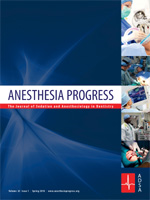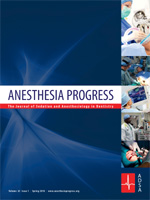
Anesthesia Progress volume 66 issue 4
The idea of providing in-office general anesthesia (IOGA) attempts to combat this issue and offer complete comprehensive oral health care to pediatric patients in a faster, more comfortable and less expensive capacity.
LAWRENCE, Kan. (PRWEB)
January 09, 2020
Anesthesia Progress—Regular dental visits for children are just as important as their annual cleaning to ensure they are in good, overall health. Unfortunately, a significant number of children go without oral health care for myriad of reasons, including anxiety, cost and the number of visits to treat a single problematic tooth. Often, pediatric dental cases will be sent to the hospital operating room to be done under general anesthesia, which requires longer wait times and a higher expense. The idea of providing in-office general anesthesia (IOGA) attempts to combat this issue and offer complete comprehensive oral health care to pediatric patients in a faster, more comfortable and less expensive capacity.
Researchers from the Cincinnati Children’s Hospital Medical Center and the University of Cincinnati published a study in the current issue of Anesthesia Progress that compared the use of traditional oral sedation with IOGA for pediatric patients undergoing dental procedures at Cincinnati Children’s Hospital Medical Center.
The researchers conducted a retrospective analysis examining oral sedation occurring pre- and post-IOGA accessibility with IOGA procedures. There were 930 pre-IOGA oral sedation patients ranging in age from 21 months to 13 years of age; 508 post-IOGA patients with an age range of 21 months to 15.5 years; and 418 IOGA patients ranging in age from 21 months to 13 years. The researchers focused on the percentage of completed cases within each patient population, as well as the percentage of radiographic exams, serious adverse effects, procedure time and repeat patients.
The researchers found the percentage of completed cases with oral sedation fell slightly from the pre-IOGA (88.6%) to post-IOGA (85.2%); however, 99.5% of all IOGA cases were completed. Dental radiographs increased from pre- to post-IOGA oral sedation patients (63.4% versus 3.5%), and 100% of IOGA had complete radiographs. There were no serious adverse events in any of the oral sedation patients, and only one case in the IOGA patients (0.2%). The overall procedure time was longer for IOGA cases (84.9 minutes) compared with pre- (67.9 minutes) and post-IOGA (68.1 minutes); however, the recovery time for IOGA cases was 15 minutes, whereas oral sedation could take up to 30 minutes. The number of repeat patients decreased from pre- to post-IOGA patients (11.1% vs. 5.9%), and only 0.9% of IOGA patients had a repeat visit.
The researchers conclude that IOGA improves access to treatment for pediatric dental patients. Not only does the completion of cases improve dramatically, but the number of radiographs and full dental examinations as well, which gives the necessary comprehensive oral health care to pediatric patients.
Full text of the article, “Impact of Instituting General Anesthesia on Oral Sedation Care in a Tertiary Care Pediatric Dental Clinic,” Anesthesia Progress, Vol. 66, No. 4, 2019, is now available here: https://www.anesthesiaprogress.org/doi/full/10.2344/anpr-66-02-02
About Anesthesia Progress
Anesthesia Progress is the official publication of the American Dental Society of Anesthesiology (ADSA). The quarterly journal is dedicated to providing a better understanding of the advances being made in the science of pain and anxiety control in dentistry. The journal invites submissions of review articles, reports on clinical techniques, case reports, and conference summaries. To learn more about the ADSA, visit: http://www.adsahome.org/.
Share article on social media or email:

